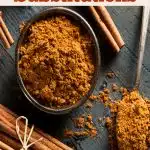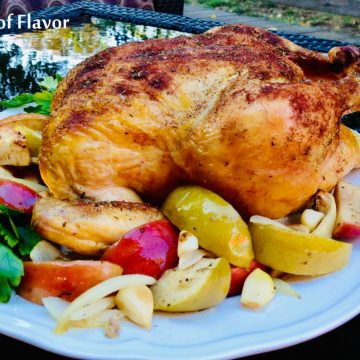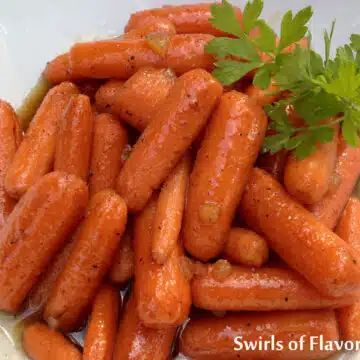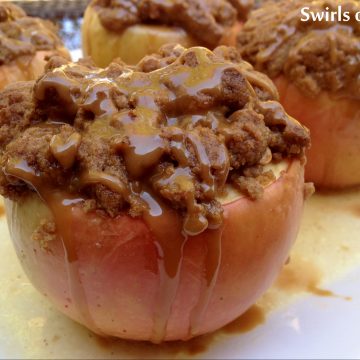Cinnamon is a warm and aromatic spice that complements both sweet and savory dishes. It is a versatile and essential spice in many kitchens and, if needed, there are plenty of Cinnamon Substitutions that can provide similar warmth and complexity.

If you happen to run out of cinnamon, there are several good substitutes that can provide similar flavors and depth to your recipes.
Jump to:
Introduction
Whether you're baking, cooking, or making a comforting beverage, many times cinnamon is a key ingredient.
If you run out of cinnamon or need an alternative due to dietary restrictions or allergies, there’s no need to be concerned because there are several acceptable alternatives for cinnamon and most are probably in your spice cabinet.
First, let’s explore cinnamon, its types, how to store it properly, and then the best substitutes to use when you need a replacement.
Several of these suggested substitutes have similar flavor profiles to this aromatic spice.
By understanding cinnamon and its possible alternatives you can make the most of this popular spice and its substitutes in your cooking and baking adventures.
What Is Cinnamon?

Cinnamon is a favorite spice of many and is known for its warm, sweet, and woody flavor that enhances both savory dishes and sweet treats.
This popular spice has a long history dating back thousands of years and includes both culinary and medicinal uses.
It is a spice that comes from the inner bark of trees belonging to the Cinnamomum genus.
This bark gets harvested, dried and rolled into cinnamon sticks or ground into powder.
The essential oil of this beloved spice, cinnamaldehyde, gives cinnamon its distinctive flavor and aroma.
Known for its warm, sweet, and slightly spicy flavor, cinnamon it a popular ingredient in baking, curries, teas, and spice blends.
Types of Cinnamon

There are several varieties of cinnamon, each having its own distinct and unique characteristics. Varieties of cinnamon include:
Ceylon Cinnamon
- This variety is referred to as "true cinnamon"
- Ceylon cinnamon has a light delicate, sweet flavor with subtle citrus undertones.
- It is commonly used in desserts and fine cooking.
Cassia Cinnamon
- This variety is the most widely available type
- Cassia cinnamon has a spicier, stronger flavor and is darker in color.
- This type of cinnamon is often found in grocery stores and used in a variety of everyday cooking and recipes.
Saigon Cinnamon
- Saigon cinnamon is known for its bold and peppery flavor
- This variety has a high oil content, making it more intense and aromatic than other varieties.
Korintje Cinnamon
- This cinnamon variety is commonly used in commercial baking
- Korintje cinnamon is milder than Saigon cinnamon but still delivers a robust cinnamon taste.
Expert recipe tips
Consider these tips when deciding which substitute you are going to use:
- Savory - For savory recipes, cloves or cardamom may be more suitable.
- Sweet - For sweet recipes, nutmeg or vanilla extract are good alternatives that will work well.
- Adjust quantities - Some substitutes, like cloves, are more potent than cinnamon, so use them sparingly.
- Combine spices - Cinnamon’s flavor is complex so you can always try mixing several substitutes like nutmeg and ginger and make your own spice blends
Uses of Cinnamon

Cinnamon is a versatile ingredient that is used in a variety of recipes around the world. Some common uses include:
- Baking – Cinnamon is used to flavor cookies, cakes, and cinnamon rolls.
- Beverages – Cinnamon will spice up your drinks such as coffee, tea, hot chocolate, or mulled wine.
- Health Drinks – Cinnamon is known to have health benefits and is often combined with honey, warm milk or warm water.
- Preserves – Cinnamon adds a delightful flavor to jams and pickles.
- Savory Dishes – Cinnamon adds a depth of flavor when added to curries, stews, or marinades.
Storage
- Cinnamon should be stored in an airtight container away from heat, light, and moisture to maintain its freshness and intensity.
- Ground cinnamon lasts about six months to a year when stored in a cool dark place such as in your pantry or kitchen cabinet.
- Whole cinnamon sticks will stay fresher longer than ground cinnamon and can retain their flavor for up to two years. Cinnamon sticks should also be stored in an airtight container in a cool dark place.
- To extend the shelf life of your cinnamon you might want to consider storing it in the refrigerator or freezer.
- Always check for a fresh aroma before using to ensure that the spice is still flavorful and potent.
- See more guidelines at USDA.gov.
Best Cinnamon Substitutes
If you are out of cinnamon, need to replace it for dietary reasons or are just looking to experiment with different flavors, there are quite a few Cinnamon Substitutions that you can try. Here are seven alternatives to check out:
Allspice

Flavor Profile - This spice has notes of cinnamon, nutmeg, and cloves
Best Uses - Baking and savory dishes.
Substitution Ratio - Use an equal amount of allspice for cinnamon in both sweet and savory recipes.
Apple Pie Spice

Flavor Profile - A blend of cinnamon, nutmeg, ginger and allspice, apple pie spice will give you a balanced warmth and sweetness in recipes
Best Uses - Baking and fall-inspired recipes.
Substitution Ratio - Use the same amount as the recipe calls for cinnamon.
Cardamom

Flavor Profile - Sweet, slightly citrusy with floral notes and spicy undertones.
Best Uses – Baked goods, teas and curries.
Substitution Ratio - Use an equal amount for a milder flavor.
Cloves

Flavor Profile - Very strong, sweet, and slightly bitter taste.
Best Uses - Savory dishes and spiced beverages.
Substitution Ratio – Use this replacement sparingly because cloves can overpower a recipe. I recommend using half the amount of ground cloves as cinnamon.
Ginger

Flavor Profile - Ginger is sharper and more aromatic than cinnamon with warm and slightly peppery notes that can come across as sharper and spicier than cinnamon.
Best Uses - Cookies, breads, spice mixes and savory recipes.
Substitution Ratio – You can use an equal amount of ground ginger but you may want to play around with this based on personal preferences.
Nutmeg

Flavor Profile - Nutmeg has a warm, slightly sweet, and nutty flavor
Best Uses - Desserts, custards, and beverages.
Substitution Ratio - Ground nutmeg is strong so be sure to use half the amount of nutmeg as the recipe calls for cinnamon.
Pumpkin Pie Spice

Flavor Profile - A blend of cinnamon, nutmeg, ginger, and cloves. This spice blend is a good alternative that closely resembles the flavor of cinnamon
Best Uses - Baking and fall-inspired recipes.
Substitution Ratio - Use the same amount as the recipe calls for cinnamon.
Recipes with Cinnamon
Easy Food Substitutions
If you need more ideas for food substitutes, be sure to check these easy food substitutes out too:
- Orzo Substitutes
- Parsley Substitutes
- Substitutes for Green Onions
- Substitutes for Maple Syrup
- Turmeric Substitutions
Conclusion

There are plenty of substitutes but the best cinnamon substitute for you will depend on personal preferences and what type of recipe you are using it in.
Whether you choose nutmeg, allspice, or one of the other substitutes, these alternatives offer lots of flexibility and flavor.
Try experimenting with different spices to add unique flavors to your recipes.
Whether you're preparing a hearty stew or baking a pie or cookies, one of these alternatives is sure to complement your recipe.
I recommend experimenting with different combinations to find your favorite twist on this classic spice!











Thanks for stopping by. Leave a tip or comment...